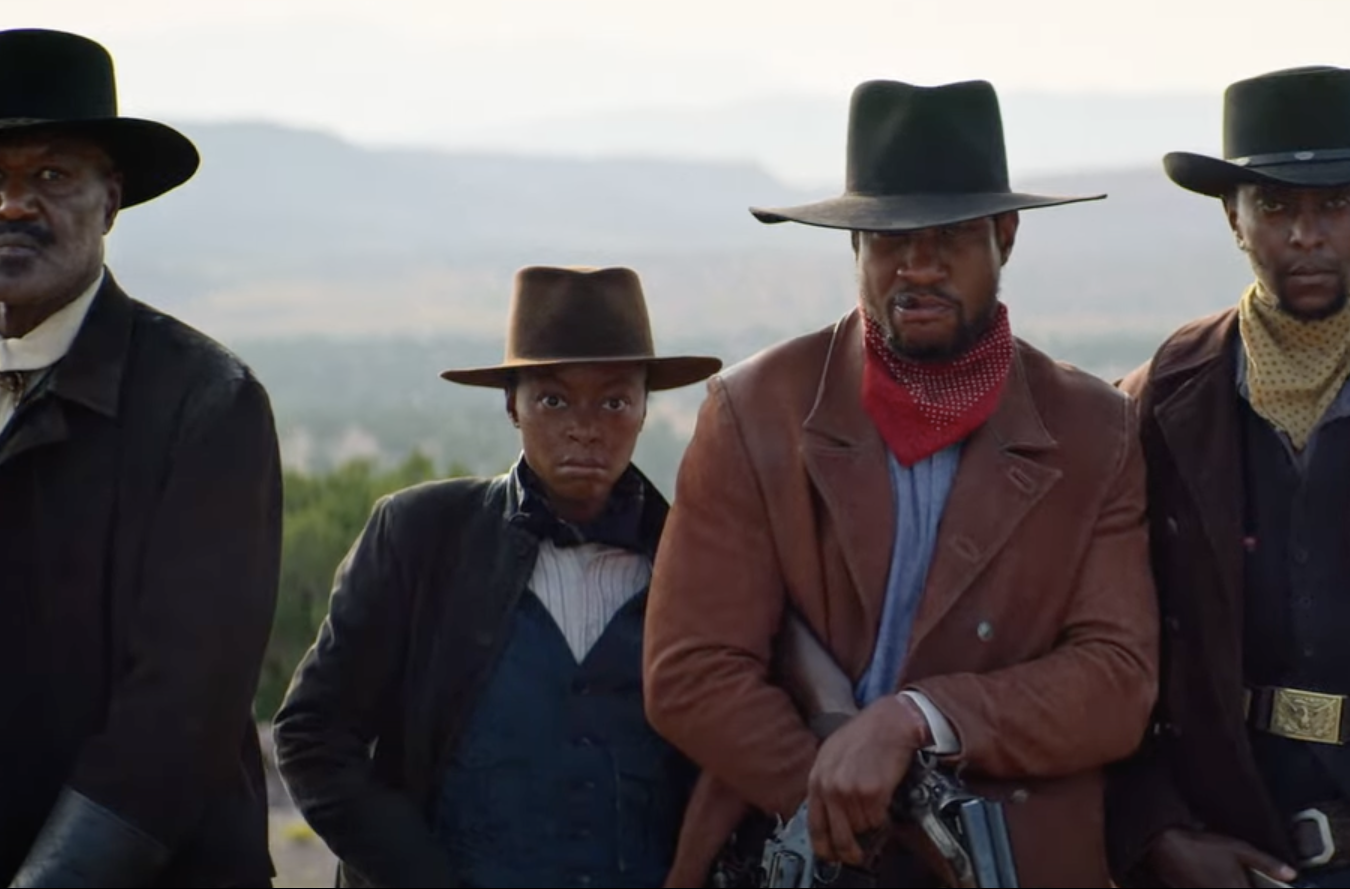Spoilers for “The Harder They Fall” ahead.
A man, his wife and their young son gather around a dinner table to eat. Before they get a chance to pray over their food, there’s a firm knock on the door. The man of the house makes his way to the front door and opens it. Before him stands a man whose face is covered by his large brim hat. Without an invitation, the mysterious man pushes his way through the door and takes a seat at the table.
He draws two golden guns and lays them on the table, one gun pointed at the little boy, the other pointed at the woman of the house. The man of the house pleads with the mystery man not to hurt his family. Bang, the woman drops dead. The child screams. Bang, the man of the house drops dead. The child screams and pleads for his life. The mysterious man whose face remains hidden pulls out a pocketknife and carves a cross into the young boy’s forehead, and the scene ends.
If you were to ask someone what their favorite movie genre is, chances are not many people would say they enjoy watching Westerns. The popularity of Western films has declined, but the new Netflix Original “The Harder They Fall” may have just changed the game for the genre of Western films.
Every aspect of “The Harder They Fall” offers a shock factor that many may not have expected from a director with few directing credits under his belt. Jeymes Samuel, a London native also known as The Bullitts, is a filmmaker, music producer and singer-songwriter, and he is the mastermind behind the creation and development of this movie.
His lifelong love and fascination for Western culture and Old West films inspired Samuel to create “The Harder They Fall.” Most Western films before now have been centered around Caucasian cowboys as if Black cowboys were nonexistent. Experts believe that African Americans made up 20% to 25% of cowboys in the West. Samuel’s decision to create his film with an all-Black cast may be a contributing factor to the immense success of the film. Though the storyline of the film is fictional, the all-Black cast depicts real cowboys and Western icons from the 19th century who few know existed in real life.
The next time viewers see the little boy who survived the gruesome attack in the first scene of the film, later revealed to be Nat Love played by Jonathan Majors, he is now grown-up and on a mission to kill every individual who had a hand in the murder of his parents when he was just 10 years old. By the second scene, Love has killed everyone involved except their leader and the man who shot his parents, Rufus Buck, played by Idris Elba, who is detained and allegedly serving a life sentence in Yuma prison.
When Love finds out that Buck’s gang will be busting him out of prison, he gets the itch for revenge and decides to get his gang back together to bring down Buck once and for all. From there, the action and the emotion in the film intensify.
The dynamic and exaggerated way in which Samuel chooses to introduce each character adds to the entertainment of the film. Each character demands the screen when they are introduced to the audience for the first time. When Regina King’s character, Trudy Smith, gets introduced for the first time, a train is shown heading toward her at full speed as she sits upon a brown horse in the middle of the train tracks and stares at the oncoming train with a stern expression.
She shows no sign of fear as she stands her ground. The train abruptly stops right in front of her, and the train conductor runs off the train yelling at her and begins to call her the N-word. Before he can get the word out, King’s character shoots him dead, establishing from the start that racism will not be tolerated in this film.
Samuel uses this scene to build up to the release of Buck. After Smith has stopped the train, the Rufus Buck gang climbs aboard and makes their way through the train cars, passengers and a unit of soldiers to get to Buck, who is being held captive in a large steel box.
Smith looks at one of the soldiers and commands him to open it, and when he makes up a lie as to why he cannot open the door, one of the members of the Buck gang shoots and kills another soldier. She asks him again, and he hands her the keys to the container. Smith looks at the soldier, firmly letting him know that he will be the one to open the container. Hesitant, the soldier opens the container, and a shackled Buck emerges. Everyone looks at the soldier again, who then removes the shackles from Buck’s wrists and ankles.
Upon release, the first thing that Buck asks is “Who here can drive a train?” A young, scared and shaken soldier raises his hand. Buck stares at the kid for a while and then orders his gang to kill everyone except the teenage soldier. The shooting starts, and bodies drop in slow motion.
The entire scene is powerful in so many ways. Each of the characters demands respect, yet they are all able to occupy the screen at the same time without overpowering one another. Samuel maintains the unforgettable introductions of his characters throughout the entirety of “The Harder They Fall.” The entrances of each character are intentionally dramatic. The power that he gives Smith is especially impressive because women back then had little to no authority, but in this film, she holds just as much power and authority as her male counterparts.
“The Harder They Fall” contains various shocking and unexpected details that are sure to leave viewers speechless. Unlike most Western films, “The Harder They Fall” is deeply rooted in emotions. The film explores love, anger and surprisingly even sadness. When people think about a Western film, many would not expect cutthroat cowboys to break down into tears, but Samuel changed the narrative with this movie. The new Netflix Original is centered around revenge rather than survival, but for good reason.
At the end of the film, after the dust settles and many people have lost their lives amid the crossfire, Love comes face-to-face with Buck. As Buck stares at the floor, he begins to tell Love a story about his father. He describes how his father would viciously beat his mother and would later turn his wrath on him when he tried to intervene to protect his mother. Buck also tells Love that his father was an alcoholic and a thief and that he murdered his mother in front of him when he was around the age of 10, leaving him to fend for himself.
In his adulthood, Buck searched for his father everywhere, desperate to look him in the eye and make him pay for what he did. When he finally found his old man, he discovered a sober, God-fearing man with a wife and a 10-year-old son. Realizing that Buck is alluding to the fact that they shared a father, tears begin to roll down Love’s face, and he shakily points a gun at Buck, who is now inches away from him. Tears begin to well in Buck’s eyes as well as he explains why he killed their father but allowed his little brother, Love, to live. Buck goes on to tell Love that he is just as violent and dangerous as he and their father were.
“You gonna surpass even me because I couldn’t kill my brother. Yet here you are about to kill yours,” says Buck as he looks his little brother in the eyes. “It’s time to take your revenge, Nathaniel Buck.”
Love turns his back and begins to walk away from his brother, but Buck refuses to drop the situation. Buck walks closer to his brother, calling him Nathaniel Buck and tantalizing him. Finally reaching his breaking point, Love turns to his brother and pulls the trigger on his pistol. One…two…three…four…five…six bullets shoot into Buck’s body. He falls to the ground.
After the first six bullets, Love’s gun is empty, but he continues to pull the trigger. Tears stream down his face as anger and frustration overtake him. He pulls the trigger a total of 17 times. As Love continues to pull the trigger on an empty gun, the audience can feel the rage that he has carried around for so many years. The entire scene is laden with a mix of emotions.
“The Harder They Fall” is a must-see movie. The strong storyline, creative camera angles, original dialogue and movie soundtrack adds excitement and wow-factor to the new tit-for-tat Western original. Samuel proved that Black creators are more than capable of telling their own stories without degrading Black culture.
Samuel left no stone unturned in his new project. The film’s soundtrack, made up of hip-hop, reggae and country beats, was co-written by Samuel and added to the emotional and intense impact of the film. After watching “The Harder They Fall,” it is evident that Samuel has high respect for Westerns and Black cowboys who have gone unacknowledged. He clearly wanted people to see Black cowboys and the Old West in a positive light, and he achieved just that.

















